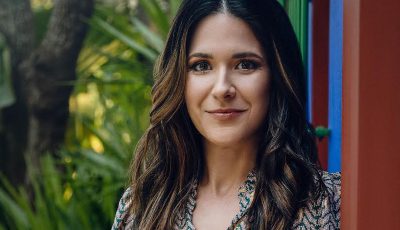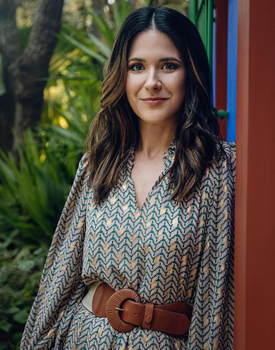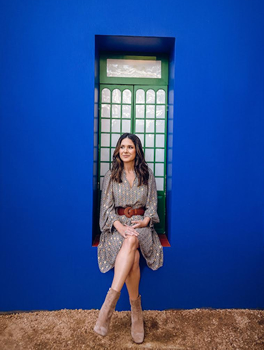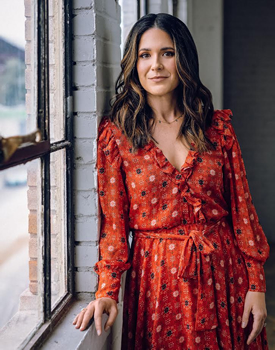

BookTrib Spotlight: Katie Gutierrez
An Affair Becomes a Marriage, Becomes a Murder
For every story told out loud, there is the story we only tell ourselves. And behind that—somewhere, out of reach—is the truth. The trick is telling them apart.
The speaker in Katie Gutierrez’s MORE THAN YOU’LL EVER KNOW is Cassie Bowman, a writer who grew up watching Dateline and reading true crime: “When it’s done right, true crime tells us who we are, who we should fear, who we are always in danger of becoming.”
Cassie knows about fear. Growing up with a cruel father, an abused mother, an abandoned brother, even now, when she is engaged to a good man, she can not bring herself to commit: “He believed people were inherently good and didn’t like looking at evidence to the contrary. I never wanted to be surprised again, so I looked and looked until even my dreams were bloody.”
Her job is to prowl the internet, searching for clickbait for the true crime blog she writes, but she feels stuck—until she comes across the story of Delores “Lore” Rivera. In 1985, Lore married a widower and father named Andres Russo in Mexico City, even though she was already married to Fabian Rivera in Laredo, Texas, with two sons of her own. A banker, she was able to move between the two men, the two families, the two countries, for many months, until a devastating earthquake caused the truth to come out, and the result was almost as devastating. Before long, one husband lay dead; the other imprisoned for his murder.
What a story! A female bigamist whose crime led to murder? And Delores Rivera was still alive. If Cassie could convince her to talk, to tell her side of the story…this could be big.
But she has no idea what she’s getting into. Delores Rivera is a formidable woman, and her story is nothing like what Cassie—or anyone else—suspects. Seizing the opportunity, Lore makes a deal, but on her own terms: “I have never made myself out to be a victim. And I am not starting now.” Every word has a price, every revelation demands something in return.
As Cassie spends day after day with her, interviews friends, family, and colleagues, examines the case files, she begins to feel that she’s getting deep inside Lore, inhabiting her, moving toward the truth. But who is inhabiting whom? And the truth? The closer she gets, the more unsure—and dangerous—it becomes….
Cassie’s mother, a teacher, had always told her that history was written by those who had power and wanted to keep it: “So, when you read your textbooks, ask yourself who is telling the story—and what they have to gain by your believing it.”
Cassie is about to find that out the hard way.
MORE THAN YOU’LL EVER KNOW is a stunning portrait of two complex women, each filled with guilt, hunger, restlessness, terror, elation; each with a great deal to gain—and to lose. How far will they go? As far as they have to. Filled with mystery, suspense, and searing psychological drama, it’ll have you looking at the people you have always held closest to you, and wondering…do I really know them?
“When I was 22 and newly engaged,” Gutierrez says now, “I read a story about a man who’d lived a secret double life for nearly 30 years. He was a construction magnate in Florida, a father of three with his wife of 53 years. Only 20 miles away, he raised two other children with another woman. Neither family knew about the other until his first wife died, and he married the second woman two weeks later.
“As I planned a wedding—a life—I thought often about this man. I wondered if he ever forgot his real name. If he ever held a newborn and was struck by the resemblance to a sibling they’d never know existed. I wondered what he meant when he told each woman he loved her. I felt both shaken and fascinated by how we can spend our lives with people and never really know them.
“Years passed. I got divorced and remarried. I became a mother. Occasionally, I came across—or searched for—another double life story. I noticed that the person with a secret family was always a man. Which makes sense: everything about a patriarchal society enables a man to keep these secrets, if he chooses to. But what if a woman did it—a mother? And what if it happened in my own hometown?
“I was born into one of the worst recessions Laredo, Texas, had ever seen. A South Texas border town and self-proclaimed retail city, Laredo depends on income from ‘across’—so when the peso crashed in 1982, the city struggled to survive. One in three people were unemployed. My dad moved up to Austin for a time, sleeping on a warehouse floor with undocumented Mexican laborers while he tried to drum up business for his electrical supply store. My mom, a college professor, tried to manage with a newborn at home.
“I envisioned a city in turmoil, a husband lost without his ability to ‘provide,’ a woman just bold, selfish, and curious enough to explore another love, another life—and all of these characters Mexican American, like me, living in a place where their identity is not a source of oppression, but a source of power.
“Then I wondered: if my characters lived in a city where they enjoyed the privileges of the majority, how might that bubble burst if it were seen by an outsider? This is where the double life story collided with a growing fascination of mine: our cultural obsession with true crime and how women are its most voracious audience, despite—or perhaps because of—being disproportionately represented as victims. I wondered how an aspiring true crime writer might see, and perhaps try to appropriate, this double life story, even with the best intentions to approach it ethically. And how might it be complicated if the writer was not, herself, Mexican American? I wanted to explore the moral ambiguities of true crime, the cost of ambition, and the responsibility a writer has toward her subject.
“More than anything, I wanted to write about two women who aren’t all good or all bad, and who struggle against the enormous consequences of their decisions. I hope I’ve done them justice.”
Lore is not at all what Cassie expects—she not only has her own hidden agenda, she is much more complicated and possessed of a much stronger agency than Cassie, or the reader, is prepared for.
“I am so glad this came across! Cassie’s background, both as a true crime aficionado and someone who’s grown up with her own trauma, predisposes her to see women as victims, despite the fact that she’s set out to write a crime story that could be viewed as feminist—there is no dead woman; instead, the woman is the perpetrator.
“In her relationship with Lore, Cassie holds a certain amount of power—she will be the one responsible for crafting the narrative. She’s also white, while Lore is Mexican American, which of course comes with inherent privilege. I was interested in exploring what happens when a crime writer who wants to write a different kind of crime story butts up against the genre’s tendency to represent women as victims, mixed with her own blind spots and biases, her own power and privilege.
“And I wanted Lore—a Mexican American woman set to become the subject of a book from which she won’t profit—to surprise both Cassie and the reader, who comes in as a sort of voyeur. The reader also has power—to interpret the story, to make meaning. I wanted to play with that dynamic by giving Lore complete agency, an unapologetic ownership of herself and her decisions, including the way she chooses to tell the story. She is the ultimate meaning maker.”
Gutierrez also felt it was important for Lore to be Latinx.: “In the first 20 years of my life, I read one book by a Latinx author: The House on Mango Street, by Sandra Cisneros, in seventh grade. I remember being struck by her use of Spanish and Spanglish in the book—a little awed, like, ‘I didn’t know you could do that!’ But also, ‘You can’t do that, can you? I’ve never seen it in literature before, so this can’t be ‘real literature!’ Of course it was. It was trailblazing.
“I was already writing stories then, and until I was in my early 20s, all my stories and novel attempts featured characters with no last names, in nameless cities. I thought I was ‘universalizing’ my stories, making them relatable to ‘the average reader.’ I thought names and places and people like the ones I knew and loved were too specific—that this imagined average reader wouldn’t understand or care about Mexican Americans in a South Texas border town.
“Now I see I wasn’t universalizing; I was erasing. The ‘average reader’ I imagined was white. To be white was to be the average, the norm, the majority. This was an incredibly ironic internalization because I grew up in a city that was 99 percent of Mexican descent. I was the majority! I had never been marginalized. I loved being Mexican. On top of that, my parents raised me to feel valuable, capable, and supported. Yet, there I was, shaving off these defining parts of myself to fit into the literary landscape as I saw it—and as it was: very, very white. Though I was determined to write and publish books one day, and I didn’t believe being Mexican would hold me back, I was still—completely unconsciously—imaginatively gatekeeping myself, all because of that lack of representation.
“I started reading and writing Latinx stories when I was in my early to mid-20s, and it felt like finally putting on clothes in the right size, or finding the person you’ll love for the rest of your life—a sense of ohhhh, this is how it’s supposed to feel. Not only did it free me creatively, but now I also feel a responsibility to my younger self, and to anyone who’s ever doubted they—or their family, their language, their culture—belong in literature. We do belong. We make it better.”
Circling back to the author’s spotlight on true crime and its moral ambiguities, was the genre always an interest of hers, or did it require research?
“Both! I’ve always been drawn to crime fiction in novels and TV, starting with Nancy Drew as a very young kid and network TV procedurals like Law and Order: SVU not long after that. For a long time, my awareness of true crime was in the background, relegated to the occasional Dateline, Cold Case Files, or documentary.
“When Serial came out, I became obsessed along with the rest of the world, and my interest in true crime grew as it seemed to be growing in the cultural zeitgeist. I watched documentaries like Making a Murderer and The Staircase, read the original serialized Dirty John in the LA Times, as much because I was curious about why we’re so interested in crime stories as in the stories themselves. That was the beginning of interrogating myself: what about crime stories has always drawn me in? Some of the most thoughtful analyses I read came from Alice Bolin (Dead Girls) and Rachel Monroe (Savage Appetites). I became fascinated by the fact that women are the biggest audience for true crime, despite—or perhaps because of—being disproportionately represented as victims.
“Only a quarter of all homicide victims are women—that statistic surprised me!—though, of course, when women are murdered, the violence is more likely to be sexualized and to be committed by a current or former partner, rather than a stranger. I became really interested in this representation of women as victims but also who is allotted the dignity, in a sense, of victimhood. Why do we all know the names JonBenét Ramsey and Natalie Holloway and Gabby Petito and not Lina Sardar Khil or Monika Diamond or Lauren Cho?
“And I became interested in the power dynamics of true crime storytelling and the complicity of the true crime audience (myself included). Is there a way to explore crime, to use it as a lens through which to shine light on human psychology, the justice system, and other systemic issues without re-victimizing the victims and their families? How can victims and their families maintain a level of power in the relationship between journalist and subject?
“As part of my research, in addition to the work I already mentioned by Alice Bolin and Rachel Monroe, I read several excellent journalism and true crime books that I think are in conversation with similar ethical questions: I’ll Be Gone in the Dark (plus the HBO documentary), by Michelle McNamara; The Journalist and the Murderer, by Janet Malcolm; Unspeakable Acts, by Sarah Weinman; The Fact of a Body, by Alex Marzano-Lesnevich; and What Happened to Paula, by Kathrine Dykstra, among others. I also spoke with veteran true crime journalist Suzy Spencer, who shared some of the challenges she faced while writing her many books.
“I think I’ve come out of this project an even greater fan of true crime—though it still feels strange to say ‘fan’ of ‘true crime’—but much more cognizant about the ways I’m prepared to engage with the genre, and I’d love it if the book made readers ask themselves similar questions.”
Writing the book wasn’t easy, though: “I’d just learned I was pregnant with our first child. I didn’t know what my writing life would look like after having a baby. I felt a sense of urgency, as though it was now or never (a damaging myth I think many women internalize about their careers).
“My pregnancy was painful, and I was less than halfway through the first draft when I stopped writing at seven months pregnant. Four months after my daughter was born, she wasn’t napping, we weren’t sleeping, and I remember crying at the kitchen table to my husband, telling him all my fears about not finishing the book were coming true.
“Shortly after that, my daughter started napping, and the naps became regular. I was still exhausted and there were always other things to do, but I chose to write during those hours, almost every day. I learned to slip into the work quickly, without procrastination, which was a gift. And the writing itself felt like a delicious, necessary escape from the monotony of early motherhood. It was a release valve.
“Using those naptime hours, I finished the first draft a few days before my daughter turned one. It wasn’t a glamorous process. I wasn’t thinking much about craft. I was just doing the work, which was really only beginning. I ended up editing the novel with my brilliant agent, Hillary Jacobson, over the next 18 months. She must have read 20 drafts of this book, and every time I sent her a new one, I hoped it was the last. But we didn’t get there until September 2020, only a few days before I had my second child!
“For me, the revision process is where I think about craft. In this book, it was about the balance between plot, character, and sentences. I cared equally about them all, but there were times a desire to delve deeper into a character slowed down the suspenseful elements, for example, and needed to get fine-tuned; conversely, one of the greatest challenges was making Cassie as compelling a character as Lore, whose extreme decisions and specific voice
made her more interesting to early readers, setting the Cassie chapters at a disadvantage. Each editing round, both before and after the book sale, seemed to focus on a different issue, starting broad with structure and ending with the sentences themselves. In the end, it was a very collaborative process between first my agent and me, and then my amazing editors—Jessica Williams at William Morrow and Joel Richardson at Penguin Michael Joseph in the U.K.—and me. The book is truly a product of having several very smart readers helping me make it better.
“It wasn’t my first novel, though. I wrote that between 2015-2017, and when I began querying agents with it, I got five offers of representation within a few weeks. This was not how I’d expected it to go! I decided to work with Hillary, and we did some minor edits on the novel over the next few weeks. After how quickly the agent search went, I allowed myself to dream big when we went on submission. Then . . . the book didn’t sell.
“It was crushing but also confusing. The feedback we received was so positive but also very mixed: the specific thing one editor loved, another said didn’t work for her. There appeared to be no clear pattern for revision. I think even Hillary was a little baffled. We got on the phone to strategize whether to submit to smaller, indie publishers, but when I told her about my next book idea— MORE THAN YOU’LL EVER KNOW she suggested we put the first novel aside for now and try to swing big again with the next one.
“I don’t know that I would have agreed if I’d known how long it would take—three years from that phone call. But Hillary’s support, dedication, and belief never wavered. We went on submission one week after I had my second child. It was a Friday, September 11. It was now my second time on submission, and I knew that no matter how hard I’d worked on this book and how proud I felt of it, it might not sell.
“I think having a newborn was the only thing that could have distracted me that weekend! On Monday, Hillary called at nine a.m. to tell me several editors already wanted to set up phone calls. I burst into tears, and we scheduled three or four calls for the next day, Tuesday. Tuesday morning, I got a call from Hillary and my amazing U.K. agent, Sue Armstrong at C+W. We hadn’t even gone on submission yet in the U.K., but Joel Richardson at Penguin had received a copy of the book from a scout, and he’d made a preemptive offer.
“It was a whirlwind. If I accepted the offer by the original deadline of 5 p.m. London time, we wouldn’t go on submission there. I’d never know whether others might have offered or what those offers might have been. The idea of accepting felt almost reckless so early on, which was surreal in and of itself.
“Then I read the letter Joel had written after finishing the book, and he had seen this book, these characters, this story, both for what they were and what they could be. Still, I wanted to talk by phone. So MJ pushed the deadline till midnight U.K. time to accommodate for my U.S. calls, and Joel gamely called me at 11 p.m. his time. And…I missed it! Maybe twice! Thankfully, he got through, and we had an almost-hourlong conversation that deepened what I’d felt reading his letter—that he both loved the book and understood how to make it better. We hung up, and I emailed Sue and Hillary that my answer was yes. So that was the day my book officially sold, in the U.K. before the U.S., when I spent hours on the phone while breastfeeding a six-pound newborn. September 15, 2020. One of the best days of my life.”
She’ll be celebrating again now—but she’s made sure not to spend her time just waiting for publication. She’s been busy working on her second novel: “It’s about three women, a kidnapping, freediving, and the many ways our society fails mothers. It also takes place in South Texas with an entirely Mexican American cast of characters, and I’m really excited about it!”
I expect we all will be!
*****
Neil Nyren retired at the end of 2017 as the executive VP, associate publisher, and editor in chief of G. P. Putnam’s Sons. He is the winner of the 2017 Ellery Queen Award from the Mystery Writers of America. Among his authors of crime and suspense were Clive Cussler, Ken Follett, C. J. Box, John Sandford, Robert Crais, Jack Higgins, W. E. B. Griffin, Frederick Forsyth, Randy Wayne White, Alex Berenson, Ace Atkins, and Carol O’Connell. He also worked with such writers as Tom Clancy, Patricia Cornwell, Daniel Silva, Martha Grimes, Ed McBain, Carl Hiaasen, and Jonathan Kellerman.
He is currently writing a monthly publishing column for the MWA newsletter The Third Degree, as well as a regular ITW-sponsored series on debut thriller authors for BookTrib.com and is an editor at large for CrimeReads.
This column originally ran on Booktrib, where writers and readers meet.
- The Big Thrill Recommends: ORIGIN STORY by A.M. Adair - November 21, 2024
- Deadly Revenge by Patricia Bradley - November 21, 2024
- Unforgotten by Shelley Shepard Gray - November 21, 2024





